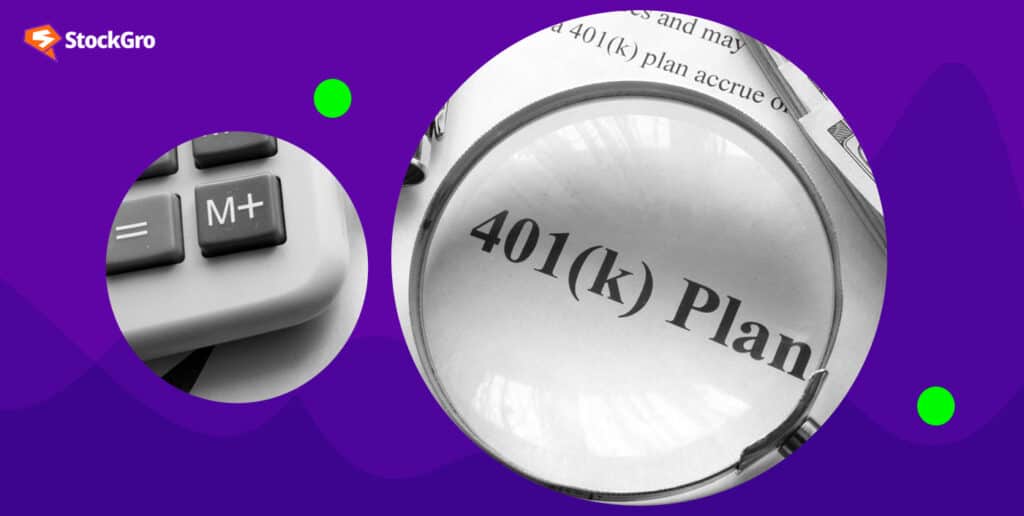
Introduction
Making retirement plans is an important part of making sure we have enough money in the future. It involves setting aside funds during our working years to support ourselves when we no longer earn a regular income.
One retirement savings option that is becoming increasingly popular worldwide is the 401(k) plan. Originating in the United States, a 401k plan offers individuals a structured way to save for retirement while enjoying tax benefits.
While the United States has the popular 401(k) plan, India offers its own retirement savings avenues like the National Pension Scheme (NPS) and the Employee Provident Fund (EPF).
Although the 401(k) isn’t directly available in India, understanding its principles can still be beneficial. So, the key question is, what is 401k plan and how does it work? This guide will provide the answers. Let’s first start by answering the question: what is a 401k plan?
What is a 401k plan?
A 401(k) plan is a retirement savings plan offered by employers to help employees save for their future in the US. It offers tax benefits and allows employees to make annual contributions up to a certain limit. Employees can choose to have a portion of their income automatically deducted from each paycheck and invested in their accounts.
Now you must be thinking, what is 401k plan in India? A 401k plan design is similar to an Employee Provident Fund (EPF) in India, but some differences exist. For example, in India, both the employee and employer contributions are tax-free, while in the US, only the employee contribution is tax-free.
Also, in India, withdrawals from EPF are allowed after 58 years of age, while in the US, withdrawals from 401k are allowed after 59.5 years of age.
Also Read: Personal Loan vs EPF Advance: Which is Better for Financial Needs
How does a 401k plan work?
A 401(k) plan allows employees to save a portion of their salary for retirement, with contributions deducted directly from their paychecks. These contributions are invested in various options like stocks, bonds, and mutual funds, chosen by the employee.
Employers may also contribute to the employee’s 401k account, often matching a portion of the employee’s contributions. In general, Employers usually offer two kinds of 401(k) accounts, each with its own tax advantages.
- Traditional 401(k): In a traditional 401(k), money is taken out of an employee’s paycheck before taxes are applied, which lowers the amount of taxable income they have. This means they don’t pay taxes on that money or any profits it makes until they take it out during retirement. The money put into a 401(k) is then invested in things like mutual funds, which can increase in value over the years.
- Roth 401(k): The Roth 401(k) is funded with money from an employee’s paycheck after taxes have been taken out, so contributing doesn’t lower your taxable income. When you take out the money in retirement, you don’t have to pay extra taxes on what you put in or on any earnings it made over time.
Over time, the invested funds grow, providing a source of income during retirement. Importantly, contributions to a 401k plan enjoy tax benefits, helping individuals save more efficiently for their future.
What are the contribution limits of a 401(k)?
In 2024, the maximum 401(k) contribution is $23,000 per year for employee contributions and $69,000 for the combined employee and employer contributions. If you’re age 50 or older, you’re eligible for an additional $7,500 in catch-up contributions, raising your employee contribution limit to $30,500.
According to EPF rules, if employees earn over ₹15,000, they must contribute 12% of their wage, including dearness and retaining allowance, to EPF. Employers also contribute the same percentage.
Employees can decide to increase their contribution. However, for establishments with fewer than 20 employees, both employer and employee contribute at a rate of 10%.
Also Read: Smart ways to withdraw retirement funds tax-efficiently
Key challenges of a 401(k) plan
A 401(k) plan, while a popular retirement savings vehicle, presents several key challenges for employees:
1. Limited investment options
Some 401(k) plans offer only a small selection of investment choices, which might not suit everyone’s preferences or financial goals.
With fewer options, creating a well-diversified portfolio that balances risk and potential returns can be challenging. This limitation may result in missed opportunities for growth and could impact long-term savings outcomes.
2. Employer dependency
Employees rely on their employers to provide and manage 401(k) plans. Changes in employment status or company policies can affect access to the plan, employer contributions, and investment options.
This dependency means that individuals may lose access to their retirement savings if they change jobs or if their employer decides to alter or discontinue the 401(k) plan. It underscores the importance of understanding the terms and conditions of one’s retirement benefits.
3. Fees and expenses
401(k) plans often come with various fees and expenses, which can reduce the amount of money available for retirement.
These fees include administrative costs and charges for managing investments. High fees eat into the returns earned on investments, affecting the overall growth of the retirement account.
It’s important to understand and minimize these fees to maximize the value of their 401(k) savings over time.
4. Vesting periods
In some 401(k) plans, employer contributions may not fully belong to employees right away. Vesting periods require employees to work for a certain period before owning these contributions completely.
For instance, if employees leave the company before the vesting period is up, they might lose a portion or all of the employer’s contributions. This can affect retirement planning and job mobility.
5. Early withdrawal penalties
Early withdrawal penalties in a 401(k) plan mean that taking money out before a certain age (usually 59½) incurs extra charges. Besides regular taxes, there’s an additional 10% fee. This discourages people from dipping into their retirement savings early.
However, in emergencies or certain situations, like buying a first home or medical expenses, there might be exceptions or ways to avoid penalties, but these need careful consideration.
Does EPF also have challenges?
Yes, the Employee Provident Fund (EPF) also faces certain challenges, although they may differ from those of a 401(k) plan. Some of the key challenges associated with EPF include:
- Lack of clarity: Applicants may face challenges in understanding the amount they will receive after their application is accepted. There is also no specific guidance on allocating excess contributions from multiple retiral funds.
- Employers not depositing contributions: Employers may face severe consequences if they fail to deposit deducted contributions into employees’ PF accounts. These consequences include interest charges, penalties, criminal charges, and imprisonment.
- Calculating payment amounts: Users may face problems in calculating the payment amount and how to transfer wages from an EPF account to an EPS account.
- The gap between government yields and scheme’s returns: The gap between government yields and the scheme’s returns may widen.
Conclusion
Understanding the 401k contribution plan is essential for securing your retirement future. Unlike EPF, a 401(k) plan offers diverse investment options and employer-matching contributions, though subject to market risks.
To make informed decisions, seek guidance and consider platforms like StockGro for expert insights on stock market trading and investing. Take charge of your financial journey today for a brighter tomorrow.

